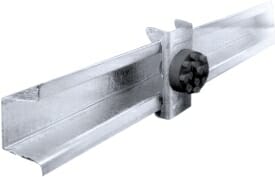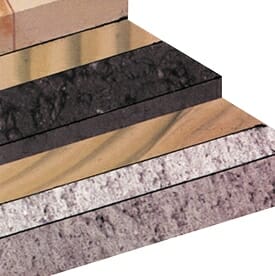Home Theater from Scratch – Design and Soundproofing Products
Dear Ted,
My basement home theater will be constructed starting in April. The room will be 17’x22′. The ceilings are 12 foot. The rooms have not yet been framed. There will be a small bathroom beside the theater and a bedroom beside the bathroom (See attachment). Since that part of the basement is completely underground, the walls currently (i.e. before framing) are concrete. A living room, kitchen, and small office are above the part of the basement where the home theater will be. What’s the most economical way of soundproofing my new home theater? I know that I need 1 soundproof door. What else should I add during construction?
S.W.
S.W.,
Thank you for the E-mail. As I’m sure you’ve found via online research, there really isn’t a set-in-stone way to answer these questions. Sound proofing is something that has to be approached as a unique, construction and situation based situation and what may work in “Room A” might not work in “Room B”, there are simply too many variables. With my disclaimer out there, I will do my best to make a few recommendations but please understand that there may be a few hundred variations that would work, it all depends on the desired result and the budget for the project. Before I get too into it, I do want to state that you should expect that no matter what you do, the low frequency (bass) is going to be the sound that makes it’s way upstairs. I can explain why, but it’s importation to know that before anything else.
Duct Work
Before the rooms are built, I would strongly suggest taking a look at the duct system for the room. This is often an overlooked detail that can literally make or break the room. You could build the most soundproof room in the world and if you leave the duct work untreated, you may as well have done nothing at all. Sound travels via the path of least resistance and is very similar to water. This first path of least resistance is always any and all common air spaces. The sound being generated in the room very quickly and efficiently finds the duct register, travels into the duct and on to the rest of the house. There are two basic ways to treat a duct, to buy and install an in-line duct silencer which is like a big car muffler for the HVAC system or to line the duct with a soft surface like our Quiet Liner. Lining the duct is always cheaper but may require a bit more work. I can explain the details in greater length if you would like, but the duct usually has to be up-sized because by putting something inside you reduce the ID (internal diameter) of the duct. I would also suggest either two 45 degree bends or one 90 degree bend so that the sound can not travel in a straight line and is FORCED to pass by an acoustical liner.
Wall/Ceiling Surfaces
After the ducts are treated, I would stuff the joist cavity with either our Quiet Liner cotton based insulation or a standard fiberglass insulation. The insulation inside of the stud cavity is not there to be a noise barrier, it is there to absorb any echo’s that would be created by a joist area that was made of all hard surfaces. It is very important to note that soft, fluffy insulation does not block sound – it absorbs echo.
 As far as the walls and ceiling are concerned, the best and most cost effective way to build them are with the RSIC-1 clips. The intent and goal of the clips is really quite simple, to stand the sheetrock off of the stud or joist. The black rubber “puck” of the clip is the piece that is doing all of the work. By floating the hat/furring channel away from the stud it acts like a shock absorber and allows the sheetrock to move and vibrate very slightly turning the sound energy into heat, by causing the vibration. As I said before, sounds are waves of energy in the air. When they hit a hard surface they transform into a vibration. This clip allows the sheetrock to flex and absorb the energy (like a punching bag absorbing a punch) so that it can not travel nearly as effectively from one side of the wall to the other. There is all kinds of information on THIS PDF that will help you. There are a few things that you will need to know about the details of this system, so if it looks like a viable option, let me know and I can go through those things with you.
As far as the walls and ceiling are concerned, the best and most cost effective way to build them are with the RSIC-1 clips. The intent and goal of the clips is really quite simple, to stand the sheetrock off of the stud or joist. The black rubber “puck” of the clip is the piece that is doing all of the work. By floating the hat/furring channel away from the stud it acts like a shock absorber and allows the sheetrock to move and vibrate very slightly turning the sound energy into heat, by causing the vibration. As I said before, sounds are waves of energy in the air. When they hit a hard surface they transform into a vibration. This clip allows the sheetrock to flex and absorb the energy (like a punching bag absorbing a punch) so that it can not travel nearly as effectively from one side of the wall to the other. There is all kinds of information on THIS PDF that will help you. There are a few things that you will need to know about the details of this system, so if it looks like a viable option, let me know and I can go through those things with you.
Door
Depending on the budget for your project, I would also suggest one of the Studio 3D door assemblies because if the walls are floating and the duct work has been treated, the door is the next weakest link in the room. These doors are custom made and have quite a few options and variables. The doors start at about $2,300.00 each, not including the installation kit ($30) and shipping which depends on where you are located. If that is completely out of your budget may want to get a good, heavy, solid core door and seal it with a door seal kit.
Floor
 Treating the floor of your room is something you may want to consider but this decision usually depends on the budget for the room as well as the desired result or amount of soundproofing that you need. Even this is a basement and I’m assuming that it’s a poured concrete floor, many home audio installers will put down our Acoustik which is a rubber based underlayment before they begin building the walls. The reason for this is because any energy that gets into the concrete will travel under the walls and not only to the other rooms in the basement, but it will travel up the concrete walls and potentially get into the rooms above because the structure for those rooms rests on the concrete. This is true, especially for the lower frequencies.
Treating the floor of your room is something you may want to consider but this decision usually depends on the budget for the room as well as the desired result or amount of soundproofing that you need. Even this is a basement and I’m assuming that it’s a poured concrete floor, many home audio installers will put down our Acoustik which is a rubber based underlayment before they begin building the walls. The reason for this is because any energy that gets into the concrete will travel under the walls and not only to the other rooms in the basement, but it will travel up the concrete walls and potentially get into the rooms above because the structure for those rooms rests on the concrete. This is true, especially for the lower frequencies.
After the room is built
You will then want to do things on the walls and floor to improve the sound quality within the room and reduce the reverberation and reflections inside of the room. I can get into the options later if you would like – I don’t want to overwhelm you as there are quite a few ways to go about this.






2 Comments
Ted W
Thanks davenycity!!! Of course there are LOTS of things to consider when designing a project like this, and if you have any particular questions, or if you would like to bounce ideas off of someone, feel free to let me know.
Thanks again!
-Ted
davenycity
great blog thank you